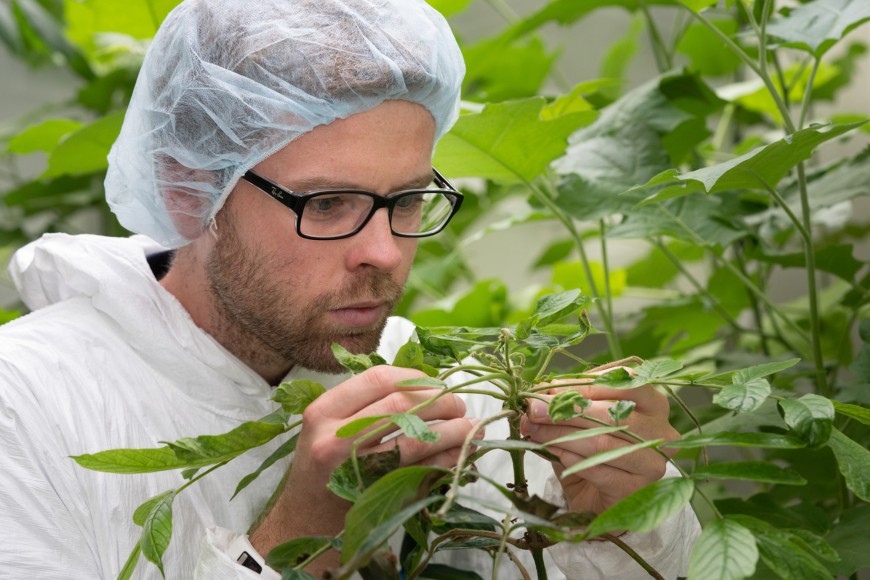Decades-long research has been generating solutions for landscape-scale weed management through developing novel biological control tools. The scope and scale of the work has seen Manaaki Whenua establish itself as a global leader in weed biocontrol.
Science Team Leader Dr Angela Bownes says weed biocontrol has been practised in Aotearoa New Zealand for nearly 100 years. It has an excellent track record for safety and success at suppressing weeds, which has helped to maintain and increase its social licence to operate.
“This is reflected in the accelerating pace at which new agents are released here, which is in stark contrast to the stagnant or slowing pace in other countries. It’s also in contrast to the slowed-down pace of agents released against arthropod pests in Aotearoa New Zealand.”
“We are currently progressing biocontrol solutions, all at varying stages in the research process, for 12 weed species in New Zealand and 10 species in the Pacific, all concurrently,” she says. Within the past 4 years Manaaki Whenua has released four new biocontrol agents against four target environmental weeds in Aotearoa New Zealand, and five new agents against four target weeds in the Pacific.

Entomology technician Arnaud Cartier inspecting the progress of African tulip trees’ natural enemies in the Invertebrate Containment Facility in Lincoln.
Most recently, Manaaki Whenua’s weed biocontrol group has been working to improve a decision-making tool for prioritising weed targets for biocontrol that was first developed for Australia by Manaaki Whenua scientists in 2008. “The framework is innovative in that it not only factors in weed importance,” says Angela, “but also predicts the likelihood that biocontrol will be successful. It also provides a ballpark cost, based on plant traits and experience in other countries.”
Recent added functionality improves how weed importance can be scored, considering their distribution and impacts across a range of habitats, as well as socioeconomic pressure to control certain species, and the ease and cost of control using existing methods. Regional councils were able to use the updated tool to rank 158 nominated weeds to help inform funding decisions made by the National Biocontrol Collective (NBC), a consortium of 15 regional councils, unitary authorities, and the Department of Conservation (DOC).
The next improvement planned for the tool is likely to be a sensitivity/risk level for different ecosystem types in which these weeds occur, including whether they occur in protected areas. Another aspect that will be explored is predicting the risk of replacement weed succession, which also needs to be considered during priority setting. “A data-driven method that flags replacement weed issues would offer additional robustness to decision-making,” says Angela.
Currently, field surveys are being used to determine when multiple species need to be tackled concurrently, such as in the Cook Islands, where grand balloon vine (Cardiospermum grandiflorum), mile-a-minute (Mikania micrantha), and red passionfruit (Passiflora rubra) are spreading, and in Vanuatu, where three pasture weeds, prickly solanum (Solanum torvum), wild peanut (Senna spp.), and hibiscus burr (Urena lobata), are making life difficult for farmers.
A key challenge for the sector remains the ability to quantify the economic value of biodiversity benefits from weed biocontrol in natural environments. “We recently conducted a holistic economic analysis for weed biocontrol in New Zealand demonstrating a phenomenal benefit to cost ratio of 73:1 for all weeds and of 110:1 for productive sector weeds alone,” says Dr Ronny Groenteman, Senior Researcher and Programme Leader for a multi-weed biocontrol project funded by the Ministry for Primary Industries (MPI) and the NBC.
“We are using these results in discussions with primary industries about becoming financial members of the NBC, as well as in our discussions with MPI about the potential next tranche of funding for weed biocontrol,” Ronny says. Funding will enable the initiation or continued assessment of the suitability of 17 arthropod and pathogen candidate natural enemies for 12 target weeds in Aotearoa New Zealand. Support from the NBC is also backing Aotearoa New Zealand’s first weed biocontrol programme for an aquatic weed, lagarosiphon (Lagarosiphon major).
The team is looking to apply a multi-criteria analysis, which can incorporate cost-benefit analyses, to the biological control of heather (Calluna vulgaris) in Tongariro National Park.
They hope this will support the positive ecosystem outcomes that emerged from a long-term study of chemical control versus biocontrol of heather in the park.
“We demonstrated that after 5 years of either herbicide application, biocontrol, both in combination, or neither, that both herbicide and biocontrol were equally highly effective at controlling heather but resulted in different (and complex) trajectories of vegetation recovery,” says Senior Technician Paul Peterson. “However, biocontrol, overall, benefited native vegetation recovery more than herbicide treatment.”
“This demonstrates how important it is to go beyond measuring success as just reducing weed abundance, which has for a long time been the key measure,” says Ronny. “There is still much to understand about the long-term responses of additional elements in the environment (soil microbiome, herbivores, insectivorous birds, rodents, etc.) to weed removal. For example, would invasion by exotic grasses following heather biocontrol encourage mammalian pests?”
A key focus for the team is to develop research programmes built on a tikanga approach to weed biocontrol. Manaaki Whenua’s Weed Biocontrol group is working with Te Tira Whakamātaki to incorporate mātauranga into weed management efforts that go beyond just biocontrol.
The group is also hoping that future funded work will allow them to focus on systematically and strategically developing biocontrol for weeds early on the invasion curve.
Key to the success of the group’s work is the fact that Manaaki Whenua’s weeds programme remains free of any sector alignment. Its work model with the NBC is unique globally, and ensures research directly responds to scientific challenges. This enables researchers to seek novel approaches to weed problems.
Key contact

